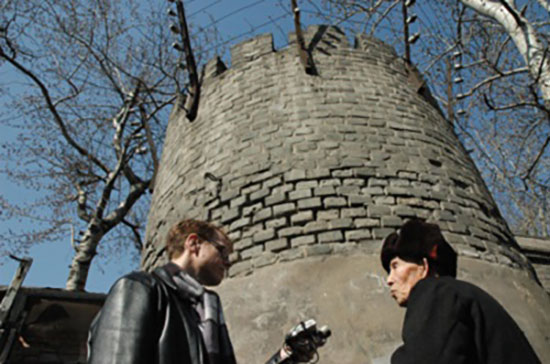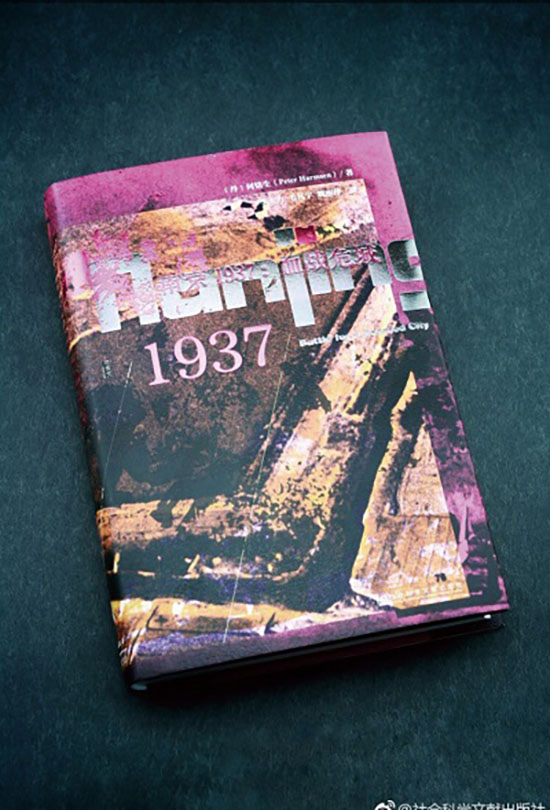


Peter Harmsen's English works. (File photo)
Peter Harmsen, a Danish journalist, worked as a foreign correspondent in East Asia for international media organizations, including Bloomberg and AFP, and sojourned in mainland China from 1998 to 2009. His English works Shanghai 1937: Stalingrad on the Yangtze and Nanjing 1937: Battle for a Doomed City were published in 2013 and 2015, respectively. The Chinese translation of the latter was released in November 2017, a month before the 80th anniversary of the Nanjing Massacre.
Speaking of the notorious crimes the Nazis committed against millions of Jews and Polish people in WWII, everyone in Western countries can tell a story or two, while few of them have ever heard of the battles in China then, not to mention the infamous Nanjing Massacre.
China’s opening up and reform policy has been going on for 30 years and the country has been playing an increasingly important role in the world, but the narration on the battles in China barely exists in the Western world. It is a paradox to Harmsen that on one hand, China enjoys enormous attention as a major power; on the other hand, WWII has always been at the center of modern history-related topics, while to most of Westerners, war in China in WWII is a blank.
Under the background of the turbulence in Chinese territory in the 1930s, conflict between the US and Japan exacerbated, leading up to the Pearl Harbor incident and resulting in war between the two countries. It is impossible to understand the ins and outs of the Pacific War in 1941 if China is not taken into consideration. Likewise, without China’s holding of a sizeable number of Japanese troops, the US’ triumph in the Pacific Ocean would not go so smooth.

Peter Harmsen interviews in China. (File photo)
The Shanghai Battle broke out on August 13, 1937 following a series of defeats of China’s resistance to the invasion of Japanese troops, ending in failure after a three-month struggle. The Japanese were not content with their gains in Shanghai and advanced swiftly westward to Nanjing, China’s capital city then, embarking on the heinous Nanjing Massacre after fierce fighting against the resistance from the people of Nanjing.
The Shanghai Battle figures prominently in Harmsen’s books because Shanghai is an iconic international metropolis known to everyone in the world no matter in the 1930s or in contemporary times. But among the Western faces living and working in Shanghai, a tiny minority is aware of the fact that the city was a battlefield in WWII. Meanwhile, an increasing number of Western historians have been attending relevant events in China, which helps China return to studies on WWII from a global background, granting China its due position in the Anti-fascist alliance.
However, most Western academies still study China’s Anti-Japanese War from a Western perspective. For instance, stories of the American volunteer group, nickname “Flying Tigers,” are told mostly by Western historians in narrating the Chinese battlefield. Perhaps it is high time for Westerners to alter their attitude toward China in history.

Book: Nanjing 1937: Battle for a Doomed City. (File photo)
(Compiled by Li Lei)
 Fire brigade in Shanghai holds group wedding
Fire brigade in Shanghai holds group wedding Tourists enjoy ice sculptures in Datan Town, north China
Tourists enjoy ice sculptures in Datan Town, north China Sunset scenery of Dayan Pagoda in Xi'an
Sunset scenery of Dayan Pagoda in Xi'an Tourists have fun at scenic spot in Nanlong Town, NW China
Tourists have fun at scenic spot in Nanlong Town, NW China Harbin attracts tourists by making best use of ice in winter
Harbin attracts tourists by making best use of ice in winter In pics: FIS Alpine Ski Women's World Cup Slalom
In pics: FIS Alpine Ski Women's World Cup Slalom Black-necked cranes rest at reservoir in Lhunzhub County, Lhasa
Black-necked cranes rest at reservoir in Lhunzhub County, Lhasa China's FAST telescope will be available to foreign scientists in April
China's FAST telescope will be available to foreign scientists in April "She power" plays indispensable role in poverty alleviation
"She power" plays indispensable role in poverty alleviation Top 10 world news events of People's Daily in 2020
Top 10 world news events of People's Daily in 2020 Top 10 China news events of People's Daily in 2020
Top 10 China news events of People's Daily in 2020 Top 10 media buzzwords of 2020
Top 10 media buzzwords of 2020 Year-ender:10 major tourism stories of 2020
Year-ender:10 major tourism stories of 2020 No interference in Venezuelan issues
No interference in Venezuelan issues
 Biz prepares for trade spat
Biz prepares for trade spat
 Broadcasting Continent
Broadcasting Continent Australia wins Chinese CEOs as US loses
Australia wins Chinese CEOs as US loses